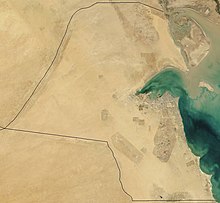Wildlife of Kuwait

Thewildlife of Kuwaitconsists of the flora and fauna ofKuwaitand their natural habitats. Kuwait is a country in theMiddle Eastat the head of thePersian Gulf,located betweenIraqandSaudi Arabia.
Geography
[edit]Kuwait is 17,820 km2(6,880 sq mi) in size, being about 200 km (124 mi) from north to south and 170 km (106 mi) from east to west. It has 195 km (121 mi) of coastline on the Persian Gulf and includes nine islands, the largest beingBubiyan Island.The main geographical feature is the largeKuwait Bay,which provides a natural harbour and on the shores of whichKuwait Cityis located.[1]The country consists largely of undulating flat land with low hills. The country is divided into four zones; a desert plateau to the west; salt marshes, mud flats and saline depressions around Kuwait Bay; sand dunes to the east; and a desert plain occupying the bulk of the country.[2]
Kuwait has an arid climate. The summer is hot and dry and the precipitation, which averages less than 8 cm (3.1 in) falls mainly in the winter in the form of unpredictable showers and as thunderstorms in spring. Dust storms can occur at any time of year but are more common in spring and summer. Average daily temperatures in the summer are around 43 °C (109 °F). In the winter, average temperate are 13 °C (55 °F), and there can be night frosts.[2]Due to Kuwait's proximity to Iraq and Iran, the winter season in Kuwait is colder than other Arabian Peninsula countries.
Flora
[edit]
Over 400 species of wild plant have been recorded in Kuwait. The arfaj is the national flower of Kuwait.[3]Desert plants are typically coarse grasses and salt-tolerant shrubs which tend to be low growing and often spiny; one of the most common plants isRhanterium epapposum,known locally asarfaj,which is used for forage bycamelsandsheep.After rainfall, annual plants spring up from seeds which may have lain dormant for years. The flowers they produce are often blue or purple and as soon as the seed is set, the plants wither and die.[4]About two thirds of the plant species are annuals with smaller numbers of perennial plants, shrubs and sub-shrubs. The native flora is in transition between semi-desert and desert vegetation and is of importance in the study of how humans are impacting semi-desert habitats. The aftermath of theGulf Warand the inundation of much of the land with hydrocarbon residues has caused considerable damage to the soil structure and considerable changes to the environment.[5]Date palmshave been planted atoasesand near the coast andmangrovesand sea grasses grow on the mudflats near Kuwait Bay, their roots helping to stabilise the coastline.[4]
Fauna
[edit]
Currently,442 species of birdshave been recorded in Kuwait, 18 species of which breed in the country.[6]Kuwait is situated at the crossroads of several major bird migration routes and between two and three million birds pass each year.[7]The marshes in northern Kuwait and Jahra have become increasingly important as a refuge for passage migrants.[7]Kuwaiti islands are important breeding areas for four species ofternand thesocotra cormorant.[7]
The Mubarak Al-Kabeer Reserve Ramsar Site on Boubyan Island consists of lagoons and saltmarshes and is visited annually by wetland birds migrating from Eurasia to Africa, and others travelling from Turkey to India. Other birds live and breed on these wetlands all year round, including the world's largest breeding colony ofcrab-plovers.[8]Among the resident birds, the commonest is thedesert lark,and inland thekestrelandshort-toed snake eagleare to be seen hunting over the desert.[9]
Away from the coast the searing heat and absence of surface water means that animals need to have special adaptations and behaviours to survive. Kuwait has only one species of amphibian, the variable toad (Bufotes variabilis), and has about 38 species ofreptile.These include theArabian sand boa,theblack desert cobra,themonitor lizardand a number of differentspiny-tailed lizards(Uromastyxspp.). Many of these spend the heat of the day in burrows, emerging at night to feed. Thefrog-eyed gecko(Teratoscincus scincus) does this, burrowing as deep as 1.2 m (4 ft) below the surface among the dunes of the coastal plains, where it remains cool and humid.[10]
Around 28 species of mammals have been recorded in the country.[5]Terrestrial mammals include several small desert rodents, thedesert hedgehog,theAfrican wildcat,thesand cat,thecaracal,theIndian grey mongoose,thestriped hyena,thegolden jackal,thefennec fox,thehoney badger,theSaudi gazelle,thegoitered gazelle,theArabian oryx,thedromedaryand two species ofbat.Thedugonghas been recorded in Kuwaiti waters in the Persian Gulf, as well as theBryde's whale,thepygmy blue whale,thehumpback whale,thefinless porpoise,theIndo-Pacific humpbacked dolphinand theRisso's dolphin.[11]
Scorpions and dung beetles abound, and in the wetlands and mudflats around Kuwait Bay and the islands there are crabs andmudskippers,numerous species of fish, waterfowl, gulls, flamingoes and dugongs.[9]
References
[edit]- ^Philip's (1994).Atlas of the World.Reed International. pp. 84–85.ISBN0-540-05831-9.
- ^abO'Shea, Maria; Spilling, Michael (2010).Kuwait.Marshall Cavendish. pp. 8–9.ISBN978-0-7614-4479-4.
- ^Omar, Samira A. S.; Bhat, N. R. (February 2008)."Alteration of the Rhanterium epapposum plant community in Kuwait and restoration measures".International Journal of Environmental Studies.65(1): 139–155.doi:10.1080/00207230701823332.ISSN0020-7233.S2CID95988423.
- ^abDiPiazza, Francesca Davis (2006).Kuwait in Pictures.Twenty-First Century Books. pp. 14–16.ISBN978-0-8225-6589-5.
- ^abKassim, Tarek A.; Barceló, Damià (2009).Environmental Consequences of War and Aftermath.Springer Science & Business Media. pp. 144–146.ISBN978-3-540-87961-9.
- ^Lepage, Denis (June 2021)."Checklist of birds of Kuwait".Bird Checklists of the World.Avibase.
{{cite web}}:CS1 maint: date and year (link) - ^abc"National Biodiversity Strategy for the State of Kuwait".7 September 2015. p. 12.Archivedfrom the original on 19 February 2016.
- ^"Kuwait becomes Ramsar state".BirdGuides. 7 September 2015.Retrieved29 January2019.
- ^abO'Shea, Maria; Spilling, Michael (2010).Kuwait.Marshall Cavendish. pp. 58–61.ISBN978-0-7614-4479-4.
- ^Balliett, James Fargo (2014).Freshwater: Environmental Issues, Global Perspectives.Routledge. p. 68.ISBN978-1-317-47015-1.
- ^The IUCN Red List of Threatened Species: Mammals of Kuwait. IUCN. 2001
